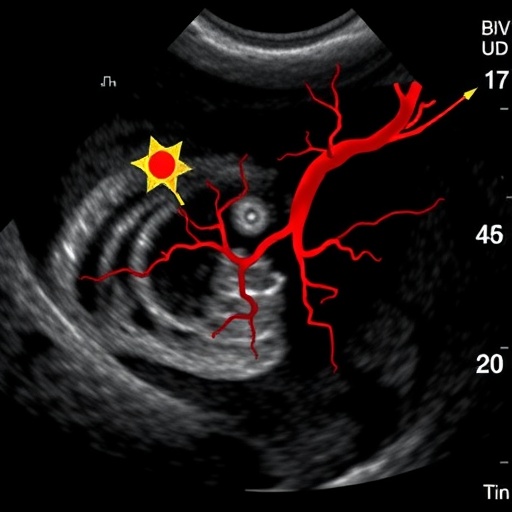Recent advances in medical imaging technology, specifically high-resolution ultrasonography, have opened new avenues for understanding the cardiovascular complications associated with diabetes. A pivotal study by Jin et al. investigates the relationship between arterial thickness measurements, macrovascular complications, and homocysteine levels in diabetic patients. This study highlights a crucial intersection of diabetes, cardiovascular health, and metabolic factors, potentially paving the way for more effective interventions and preventive strategies.
Diabetes is a multifaceted disorder known to bear significant implications for cardiovascular health. Undoubtedly, patients with diabetes experience higher incidences of macrovascular complications, including heart attacks and strokes, as a direct result of prolonged hyperglycemia and its consequent pathological changes. The research led by Jin and collaborators particularly focuses on the evaluation of arterial thickness, an indicator that can reveal much about vascular health and the underlying physiological changes in diabetic patients.
The study utilizes high-resolution ultrasonography, an imaging technique renowned for its precision in measuring arterial wall thickness. This modality allows researchers to visualize the arterial structure in great detail, offering insights that are crucial for risk stratification in diabetic patients. By measuring intima-media thickness (IMT), the study provides a reliable metric for assessing vascular health and potential atherosclerosis progression in this high-risk population.
A significant component of this research revolves around homocysteine levels, an amino acid whose elevated concentrations in the blood have been associated with vascular damage and cardiovascular risks. Homocysteine is a byproduct of protein metabolism and its role in endothelial dysfunction has seen increasing recognition in recent years. The interplay between homocysteine levels and arterial thickness could elucidate mechanisms through which diabetes exacerbates cardiovascular risk, providing healthcare professionals with vital information to guide treatment strategies.
In this comprehensive study, the authors strategically divide their subjects into two groups: diabetics with macrovascular complications and those without. The comparison between these distinct groups illuminates how arterial thickness varies in conjunction with both the presence of complications and homocysteine levels. By doing so, the research underscores the importance of personalized medicine, where the patient’s specific health condition drives targeted therapeutic approaches.
The findings from Jin et al. reveal that diabetic patients suffering from macrovascular complications exhibit statistically significant increases in arterial thickness relative to their counterparts without such complications. This observation is particularly important as it suggests a direct impact of vascular pathology on diabetic patients, emphasizing the urgent need for tailored monitoring and interventions aimed at mitigating cardiovascular risks.
Moreover, the study draws a compelling connection between elevated homocysteine levels and increased arterial thickness. This association signals a potential marker for clinicians to monitor in their diabetic patients, offering a practical tool for predicting and preventing cardiovascular events. If homocysteine can be effectively managed, the implications for arterial health in diabetic patients could be substantial.
In addition to these critical findings, the study also explores various confounding factors, including age, sex, and duration of diabetes, which could influence the relationship between arterial thickness and homocysteine levels. Such an approach demonstrates the thoroughness of Jin et al.’s research methodology, ensuring that the outcomes are scientifically robust and clinically relevant. This rigor not only strengthens their conclusions but also enhances the translational potential of their findings into everyday clinical practice.
The broader implications of this research extend into the realms of public health and diabetes management strategies. As the prevalence of diabetes continues to rise globally, understanding the relationship between metabolic factors like homocysteine and vascular complications is paramount. The results from this study could influence future guidelines on monitoring and managing cardiovascular health among diabetic patients.
Additionally, the study emphasizes the critical importance of regular screening and early intervention. Given the potential for collagen damage and arterial stiffening seen in diabetic patients, timely assessments using high-resolution ultrasonography could serve as invaluable tools for early detection of cardiovascular issues. This proactive approach could help avert severe complications, thus improving the quality of life for those living with diabetes.
The landscape of diabetes management is constantly evolving, and studies like the one conducted by Jin et al. represent a significant contribution to this field. By identifying specific markers and elucidating their relationships with key physiological changes, researchers can better equip healthcare providers in their ongoing battle against vascular complications associated with diabetes. This proactive stance signifies a shift towards more comprehensive and practical countermeasures in managing healthcare for diabetic individuals.
Ultimately, the research underscores the need for further exploration in this arena. With the findings from high-resolution ultrasonography paving the way for more extensive studies, there is hope for the development of novel preventive strategies that could revolutionize the care and management of diabetic patients at risk for cardiovascular diseases. As additional research builds on these foundational findings, the potential for improved patient outcomes becomes increasingly attainable.
In conclusion, Jin et al.’s study stands as a beacon of knowledge in understanding the complex interplay between diabetes, arterial thickness, and homocysteine levels. Their findings hold profound implications for the management of diabetic patients, emphasizing the critical need to address cardiovascular health proactively. As the scientific community continues to unravel the intricacies of metabolic diseases, such studies will be essential in steering future research efforts and enhancing health outcomes globally.
Subject of Research: The relationship between arterial thickness measurements, macrovascular complications, and homocysteine levels in diabetic patients.
Article Title: Arterial thickness measurements on high-resolution ultrasonography in diabetics with and without macrovascular complications and their relationship with homocysteine level.
Article References:
Jin, S., Zhao, S., Yue, X. et al. Arterial thickness measurements on high-resolution ultrasonography in diabetics with and without macrovascular complications and their relationship with homocysteine level. BMC Endocr Disord 25, 237 (2025). https://doi.org/10.1186/s12902-025-02064-2
Image Credits: AI Generated
DOI: 10.1186/s12902-025-02064-2
Keywords: Diabetes, cardiovascular health, arterial thickness, homocysteine, high-resolution ultrasonography, macrovascular complications, metabolic factors, preventive strategies.




